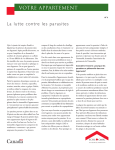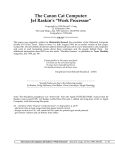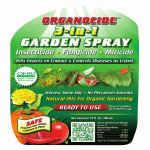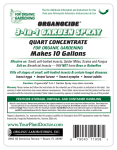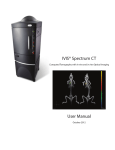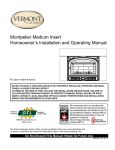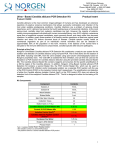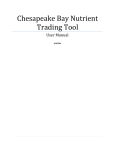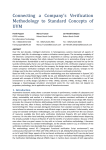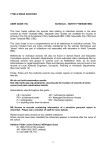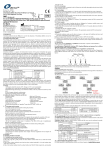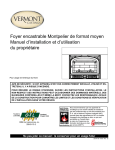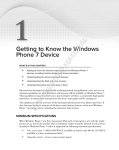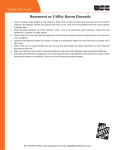Download Spring 2012 - University of Vermont
Transcript
The Pesticide Applicator Report ______________________________________________________________________________________________________ Published by The Vermont Agency of Agriculture, Food & Markets For Vermont’s Pesticide Applicators Spring 2012 Volume 14 – Issue I In This Issue: News from the Agency……………...…1 EPA Launches Beg Bug Information Clearinghouse.……..1 Play it Safe: Maintain and Fit Test Your Cartridge Respirators……...2 EPA’s Rodenticide Mitigation Decision Revision…………….......5 * * * News from UVM Extension…………...6 Reducing Your Exposure When Others Use Pesticides..……….…..6 News from the Agency EPA Launches Bed Bug Information Clearinghouse The U.S. Environmental Protection Agency is launching an online Bed Bug Information Clearinghouse. It contains peer-reviewed bed bug outreach materials from a variety of different sources such as governments, universities and extension services. Stemming from a top recommendation from EPA’s Second Annual National Bed Bug Summit, the Bed Bug Information Clearinghouse is a collaborative effort between EPA and partners in the Federal Bed Bug Workgroup. The goal of the Bed Bug Information Clearinghouse is to provide a “onestop” location for communities throughout the country to exchange information and outreach materials on the control, detection and prevention of bed bugs. This will help communities conserve resources and provide improved effectiveness and accuracy of community outreach materials. The Clearinghouse is searchable based on: * * * Home Study Quiz 1..………....….…..9 Home Study Quiz 2....……...………11 Audience – such as Hotels, Health Centers, Housing Authorities, Schools, Shelters, Residential Consumers, etc. Topic – Detection, Prevention, Non-chemical Control, Management, Pesticides Type of product – Outreach Materials such as Factsheets, Brochures, Websites, etc. The Clearinghouse will include information in English and other languages as available. Some of the current information focuses on Continued → Questions or comments regarding this newsletter? Please contact Matthew Wood at the Vermont Agency of Agriculture at 802-828-3482 or email [email protected] ________________________________________________________________________________________ identifying and treating bed bug infestations in Play it Safe: Maintain and Fit Test various types of situations. In addition, there is Your Cartridge Respirators information on several different types of treatments such as the use of heat to kill bed bugs. Written by Erin Bauer, Extension Associate, Clyde Ogg, Extension Educator, Pierce Hansen, Extension While there is no quick fix for bed bug infestations, Assistant, and Jan Hygnstrom, Project Coordinator. having accurate information about bed bug control Taken from a Nebraska Extension CropWatch will help keep the public from over-applying or Article, September 30, 2011. Used with permission. misusing pesticides. There are a variety of non© University of Nebraska-Lincoln chemical approaches for controlling, detecting and When working with a pesticide, always check the preventing bed bugs that have been shown to be label for the required personal protective equipment effective, including: (PPE) and be sure to use it. Checking for bed bugs on luggage and clothing when returning from a trip Looking for bed bugs or signs of an infestation on second-hand items, such as a sofa or bed, before bringing the item into your home Reducing clutter where bed bugs can hide Using a protective cover that encases mattresses and box springs A more informed public is a better partner in the control, detection and prevention of bed bugs. With the help of community advocates distributing outreach materials from the Clearinghouse to the public, EPA hopes that this will lead to increased prevention as well as a reduction in infestations. Visit the Bed Bug Information Clearinghouse at http://www.epa.gov/bedbugs/. Some pesticides carry a risk of inhalation exposure and require the use of a respirator. One of the most common types is the half face cartridge respirator. A new half face cartridge respirator will be packaged with an instruction manual, faceplate with straps, two cartridges, and extra accessories to attach for dust or particulate protection. Check the labels on the cartridges to ensure they provide the protection you need, whether it is against organic vapors or other particulates. As with other PPE, you should properly maintain your respirator to ensure that it offers adequate protection when you apply pesticides. This includes testing the respirator’s seal before each use, and properly cleaning and storing the respirator after each use. Refer to the instruction manual for more information about how to assemble, use, and care for your respirator. Adjusting a respirator step-by-step: Bed bugs do have a way of “clearing a house”, don’t they? 1. Place on face ____________________________________________________________________________________________________________ The Pesticide Applicator Report – Spring 2012 – Page 2 of 12 ________________________________________________________________________________________ using it again. Prior to each use, check the face seal for cracks and abrasions, and ensure that respirator components are intact. To perform a seal check, the faceplate has to fit tightly against your face. If facial hair prevents you from getting a tight seal, consider shaving or choose a different pesticide that does not require a respirator. 2. Adjust “halo” strap There are three common ways to test the seal on a respirator. Before testing, adjust the respirator to where you think you have a good fit. Start by placing the respirator on your face, then pull the top plastic strap (“halo” shaped in some models) and adjust it over and on top of your head. Next, connect the straps that go behind the neck, and pull the loose ends of the straps to adjust for comfort and fit. When you feel you have a tight seal, do the following tests to ensure your respirator is fitted properly. Positive Seal Check 3. Adjust neck straps Fit Testing Cover the exhalation valve in front of the respirator and gently exhale. If you can do this without feeling a rush of air around the faceplate, you have a good seal. Fit testing is mandatory under Occupational Safety and Health Administration (OSHA) regulations. Fit testing will determine whether the respirator size is correct for the initial user. Additionally, a new fit test may be required if there is a change in size, make, or model of the respirator you are using, or changes in user characteristics (dental work, body weight, etc.). Always follow these guidelines. Pesticide applicators need to meet certain health requirements before conducting a fit test or doing work that requires a respirator. OSHA requires that employees who will be using a respirator have a medical evaluation prior to fit testing and be properly trained in respirator use. The most important part of a fit test is obtaining a good seal. It is a good practice to test the seal on your respirator every time you put it on. Between removal, cleaning, and storage, the respirator may not fit the same, so you’ll have to readjust it before Positive seal check Negative Seal Check Cover the intake portion of each of the two cartridges with your hands and inhale gently. You also can do this test without the cartridges by simply covering the inlet holes and testing the seal. If you have a good seal you should not be able to pull any ____________________________________________________________________________________________________________ The Pesticide Applicator Report – Spring 2012 – Page 3 of 12 ________________________________________________________________________________________ air through the seal against your face. If you can Maintaining Your Respirator pull air, check carefully around the seal for damages or obstructions. If you can clear obstructions and When finished with your respirator, clean and store make additional adjustments to strengthen the seal, it properly after each use so that it’s in good simply retest the unit. If you find breaks or damaged condition for the next use. portions of the seal, you will need to replace the respirator seal or the entire unit. After removing your respirator, remove the cartridges. They generally unthread, bend, or snap out of the faceplate. If the cartridge seating is damaged during removal, do not attempt to repair or bend it back in place—simply replace the cartridges. Negative seal check Ampule Test An ampule is a small sealed vial sold by many online suppliers. Ampule testing for respirator fit is one example of several procedures that may be required by OSHA. In the ampule test, you break an ampule designed for this purpose and see if you can detect the odor (often smelling like concentrated banana) through the respirator. If you detect the odor, your seal isn’t adequate and you’ll have to make additional adjustments. Make sure to test the ampule across all portions of the respirator seal. Also, consider simulating common working motions such as moving your head up and down and side to side as a test of field performance. Cartridges absorb pesticides and other organic vapors when exposed to air, thus you can extend their life by storing them properly. Store cartridges in either the original respirator packaging or a resealable zipper storage bag when not in use. These offer airtight seals that will help preserve the cartridges by keeping out organic vapors. It is also a good idea to mark the storage container with the purchase date of the cartridges and a running tally of the number of hours used. After removing and storing the cartridges, wash the faceplate with soapy water and either air or towel dry before storing it for the next use in a clean and dry container such as a re-sealable zipper storage bag or a tight sealing plastic storage container . Store the respirator to preserve its shape and integrity, protecting it from distortion, contamination, and extreme temperatures. Also, be sure to inspect the respirator for any holes, damage, or wear and replace it if necessary. Replacing Your Cartridges A respirator cartridge has a limited life span, which is greatly affected by the condition of use, such as the temperature, humidity, work efforts of the user, and the chemical concentration and type of chemicals for which the cartridge is used. Cartridge life may be reduced if exposure to organic vapors is extensive and occurs over a short time. Many respirator manufacturers have online calculators where you can enter this information to determine cartridge life. Consult the manufacturer’s web site for such software. Smelly ampule test ____________________________________________________________________________________________________________ The Pesticide Applicator Report – Spring 2012 – Page 4 of 12 ________________________________________________________________________________________ Always replace cartridges immediately if you can EPA’s Rodenticide Mitigation smell pesticide odors when using the respirator. Decision Revision! Your new cartridges should be the same type as those you are replacing. Cartridges are color coded depending on what particulates they filter. For example, a cartridge that filters organic vapors as well as pesticide dusts, mists, and fine particles (using a P100 filter) will be magenta and black. Respirator Resources OSHA Respirator Requirements For more information about OSHA’s medical evaluation questionnaire, mandatory fit test procedures, and other respirator requirements, see www.osha.gov and search for the regulation “1910.134.” (say that 10 times fast!) The US Environmental Protection Agency (EPA) has agreed to revise the restrictions that were placed on the outdoor use of rodenticides in the Rodenticide Mitigation Decision (RMD) that originally went into effect in April of 2011. The following are the changes the EPA made to rodenticide labels: [Beware that as a Pest Control Operator, you must follow the label of the product you are using and you cannot use these new guidelines until the label of the product you are using contains this new language or you possess a copy of supplemental labeling.] The distance from a building will be extended from 50 feet to 100 feet for outdoor placement of rodent bait. The word “building” will be replaced by “manmade structures”, but fences are specifically excluded from these “structures”. No perimeter baiting beyond 100 feet from a “structure”. First generation anticoagulant and nonanticoagulant rodent baits labeled for use in rodent burrows will be permitted for use in burrows that are located further than 100 feet from man-made structures. To learn more about maintenance and fit testing of your respirator refer to the user’s manual view the UNL Extension video, Cartridge Respirator Use, and related videos on YouTube on the UNL Extension Pesticide Safety Education Channel at www.youtube.com/user/UNLExtensionPSEP. See the quiz on page 9 for a credit. To help reduce the possibility of mis-interpreting the new label language on second generation anticoagulant rodent bait labeled for use in burrows, this label language will appear: “On all second-generation anti-coagulant products labeled for application in rodent burrows:” “This product may only be applied to active burrows to control Norway rats and roof rats within 100 feet of buildings and man-made structures constructed in a manner as to be vulnerable to commensal rodent invasions and/or to harboring or attracting rodent infestations provided that infestations of these ____________________________________________________________________________________________________________ The Pesticide Applicator Report – Spring 2012 – Page 5 of 12 ________________________________________________________________________________________ rodents have been confirmed. Efforts should be made to remove food trash, garbage, clutter and debris.” News from UVM Extension “Bait must be placed no less than 6 inches into active Norway/roof rat burrows. Do not broadcast bait.” “On all first-generation anticoagulant and nonanticoagulant professional and agricultural products labeled for application in rodent burrows:” “This product may be applied to active rodent burrows to control Norway rats and roof rats within or beyond 100 feet of buildings and manmade structures provided that infestations of these rodents have been confirmed.” “Bait must be placed no less than 6 inches into active Norway/roof rat burrows. Do not broadcast bait.” “Because Norway/roof rat infestations may occur in areas farther than 100 feet from buildings and man-made structures when rodents have ample supplies of food and cover, efforts should be made to remove food trash, garbage, clutter and debris.” Reducing Your Exposure When Others Use Pesticides Ann Hazelrigg, UVM Extension (Adapted from EPA’s Citizens Guide to Pest Control and Pesticide Safety) Even if you choose to never use a pesticide you may be exposed to them at home, work, at school or at play. Exposure can occur by walking through treated areas like golf courses or parks, by eating foods that have been legally treated with pesticides, or inadvertently through food, water and air that may have been contaminated with pesticides. We can reduce our overall exposure by following a few simple guidelines. Exposure Through Food The Environmental Protection Agency (EPA) does a thorough job to ensure a safe food supply by regulating and limiting the amount of pesticide residues that can legally remain on food and animal feed sold in the US. These pesticide residue limits are known as tolerances. The EPA sets maximum residue limits (MRLs), or tolerances, for pesticides that can be used on various food and feed commodities. Inspectors from the Food and Drug Administration (FDA) and the United States Department of Agriculture (USDA) monitor food in interstate commerce to ensure that these limits are not exceeded. Below are two resources for maximum residue limits (MRLs), or tolerance information. If you would like to know more specific information on maximum residue limits, go to http://www.epa.gov/opp00001/food/viewtols.htm. Since most crops are treated with pesticides (including both organic foods and non organic foods) at some point in their growing season, the foods we purchase may contain small traces of pesticide residues. Pesticide levels tend to decrease over time because the residues naturally break down and the crop is often washed and processed before arriving at the store. Even though we all consume small amounts of pesticides on a regular basis, the ____________________________________________________________________________________________________________ The Pesticide Applicator Report – Spring 2012 – Page 6 of 12 ________________________________________________________________________________________ levels are well below legal limits by the time the Food from the Wild produce reaches the grocery shelves. To reduce the chances of ingesting trace elements of While it may seem that hunting your own game, pesticide residues you can take extra precautions; catching your own fish, or gathering wild plant foods would reduce your overall exposure to Trim the fat from meat and poultry since pesticides, that isn’t necessarily true. If you eat wild residues of some pesticides concentrate in animals or plants from areas where pesticides are fat. Remove skin from fish. frequently used, this food may contain pesticide Discard the fats and oils in broths and pan residues. In addition, birds such as ducks and geese drippings. may absorb pesticide residues if they have stopped Rinse fruits and vegetables thoroughly with to eat treated crops anywhere along their flight path. water. Scrub with a brush and peel, if If you eat food from the wild, you may want to take possible. Taking these safety steps will the following steps to reduce your exposure to remove most of the existing surface pesticides: residues, along with any remaining soil. Surface cleaning (rinsing and scrubbing) Do not fish in water bodies where will not remove pesticide residues that are contamination has occurred. absorbed into the growing fruit or vegetable Pay attention to posted signs that warn of before harvest. contamination. Cook or bake foods to reduce residues of Consult with fish and game officials or other some pesticides even further. appropriate officials where you plant to hunt Home-Grown Food or fish to determine whether there are any chemical problems associated with the area. Growing your own food without pesticides is a Do not pick wild plants that are growing great way to reduce your exposure to pesticide right next to a road, utility right-of-way, or residues in food. Be sure to select a garden site hedgerow between farm fields. These areas where no drift or runoff from a neighbor’s use of may have been treated with pesticides. pesticides will result in unintended residues on your When preparing wild foods, trim fat from fruit or vegetables. If your house or property is the meat. Discard the skin from fish. regularly treated for pest prevention, don’t plant your garden where any treatments are applied. Exposure Through Water When pesticides are applied to land, a certain amount may run off into streams and rivers. This runoff, together with industrial waste, may result in low-level contamination of surface water. In certain settings, pesticides can seep down through the soil to the ground water. To ensure a safe supply of drinking water, EPA’s Office of Water sets standards for pesticides and other chemicals that may be found in drinking water. Municipal water systems test their water routinely and provide treatment or alternate supply sources if residue problems occur. Generally, private wells are not tested unless the well owner requests an analysis. If you get your drinking water from a private well, contact the Vermont Agency of Agriculture if you have any questions about pesticide residues in your well water. If your well water is analyzed and found to contain pesticide residue levels above ____________________________________________________________________________________________________________ The Pesticide Applicator Report – Spring 2012 – Page 7 of 12 ________________________________________________________________________________________ established or recommended health standards, use Some local governments require public notice an alternate water source such as bottled water for before area-wide or broad-scale pesticide spraying drinking and cooking. activities take place. Affected residents are notified through newspaper announcements, fliers, letters, or More information on getting your private well signs posted in areas to be treated. tested can be found at the Vermont Department of Health’s website: Indoors http://healthvermont.gov/enviro/ph_lab/water_ test.aspx Here is a list of labs that are certified to do drinking water analysis: http://healthvermont.gov/enviro/ph_lab/docume nts/certified_labs.pdf Exposure Through Air Outdoors Air currents may carry pesticides that were applied on properties nearby. You can reduce your exposure outdoors to airborne pesticide residues, or drift, by following these recommendations: If a close neighbor or someone else is applying pesticides outdoors near your home, you may want to stay indoors with your children and pets. Keep windows and exterior doors closed. If you live near fields, parks, or other areas that receive regular pesticide treatment, consider planting a group of hardy, thickbranched trees or shrubs to help serve as a buffer zone or wind break. The air you breathe may contain low levels of pesticide residues long after a pesticide has been applied to objects inside a building or to indoor surfaces and crawl spaces, or after it has been tracked in from outside. Pesticides break down and disappear more slowly indoors than outdoors. In addition, many homes have built-in energy efficiency features that reduce the exchange of indoor and outdoor air and thus aggravate the problem. To limit your exposure to indoor pesticide residues— Air out the building adequately after a pesticide is applied indoors. Open doors and windows, and run overhead, whole-house, or window fans to exchange indoor air for outdoor air rapidly and completely. If you suspect that the air in your building is contaminated, consult knowledgeable professionals in your local or state health department or the National Pesticide Information Center at 1-800-858-7378, seven days a week, from 6:30 a.m.–4:30 p.m. for advice on the appropriate steps to take. See the quiz on page 11 for a credit. ____________________________________________________________________________________________________________ The Pesticide Applicator Report – Spring 2012 – Page 8 of 12 ________________________________________________________________________________________ Home Study Quiz 1 – Play it Safe: Maintain and Fit Test Your Cartridge Respirators The following questions refer to the article on pages 2-5. Fill out the information on the back of this completed quiz and mail it to the Vermont Agency of Agriculture to receive (1) one pesticide recertification credit. Circle the best answer: 1. When working with a pesticide, where is the best place to find what Personal Protective Equipment (PPE) is required to be worn? A. the Cornell Core manual B. the label of the pesticide being used C. the Vermont Regulations for Control of Pesticides 2. The main type of pesticide exposure that a respirator will protect you from is? A. oral B. dermal C. inhalation 3. Fit testing of a cartridge respirator is mandatory under what organization’s regulations? A. Vermont Agency of Agriculture, Food & Markets B. Occupational Safety & Health Administration C. US Environmental Protection Agency 4. Which of the following may require a new fit test for your cartridge respirator? A. a significant change in body weight B. a change in the pesticide formulation used C. a significant change in the weather 5. “OSHA requires that employees who will be using a respirator have a medical evaluation ______ fit testing.” A. prior to B. during C. immediately after 6. How often should you test the seal between the respirator and your face? A. once per week B. every time you change the cartridges C. every time you put it on 7. Why should the respirator cartridges be stored in an air-tight container when not in use? A. to keep the pesticide residues from escaping B. to prevent them from absorbing organic vapors from the air C. to keep the humidity in ____________________________________________________________________________________________________________ The Pesticide Applicator Report – Spring 2012 – Page 9 of 12 ________________________________________________________________________________________ The following information is required. Mail the completed quiz to the Vermont Agency of Agriculture to receive one (1) pesticide recertification credit. Name: Certificate #: Please check: Commercial Non-Commercial Government Private Street Address: City/State/Zip Company/Farm: Signature: Date: Email address (optional): Mail to: Vermont Agency of Agriculture, Food & Markets Attn: Matthew Wood 116 State Street Montpelier, VT 05620-2901 ____________________________________________________________________________________________________________ The Pesticide Applicator Report – Spring 2012 – Page 10 of 12 ________________________________________________________________________________________ Home Study Quiz 2 – Reducing Your Exposure When Others Use Pesticides The following questions refer to the article on pages 6-8. Fill out the information on the back of this completed quiz and mail it to the Vermont Agency of Agriculture to receive (1) one pesticide recertification credit. 1. Why trim fats from meats and poultry? 2. How can you reduce your pesticide exposure at home when a neighbor is applying pesticides outdoors? 3. How can pesticides get on your home grown vegetables if you have not used any pesticides? 4. What should you always do with fresh fruits and vegetables you have purchased? 5. Which agency regulates the amount of pesticide residues that can legally remain on food and animal feed sold in the US? 6. From what you have learned in this article, how do you think you can limit your family’s pesticide exposure if you live with a golfer? 7. When foraging for native edible plants what areas should you avoid and why? 8. How can you ingest pesticides by eating wild ducks and geese? 9. How can ground water contain pesticides? 10. What does pesticide tolerance mean? ____________________________________________________________________________________________________________ The Pesticide Applicator Report – Spring 2012 – Page 11 of 12 ________________________________________________________________________________________ Pesticide Applicator Report Spring 2012 Vermont Agency of Agriculture, Food & Markets Agriculture Resource Management Division 116 State Street Montpelier, VT 05620-2901 The following information is required. Mail the completed quiz to the Vermont Agency of Agriculture to receive one (1) pesticide recertification credit. Name: Certificate #: Please check: Commercial Non-Commercial Government Private Street Address: City/State/Zip Company/Farm: Signature: Date: Email address (optional): ____________________________________________________________________________________________________________ The Pesticide Applicator Report – Spring 2012 – Page 12 of 12












